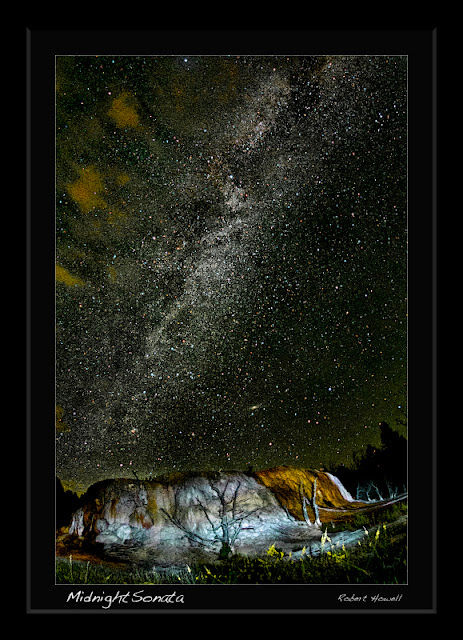
How-to have 'points of light' stars,
photos with very little star movement.
"Night
Sky Landscapes" images with both the stars and the earth kept sharp requires
the length of the exposure to be short enough that the stars do not appear to ‘trail’
due to the earth's rotation.
It mostly depends upon the focal length of your
lenses.
For an 8x10 inch or smaller image the old 600 Rule
works just fine.
It allows for the most seconds of exposure with the
least amount of noticeable star movement.
For larger prints using a number of 500 or 450 is even better – less time
to notice the Earth is rotating during the time you expose your image.
Divide the focal length of your lens into 600 and write it down. Then do the
same with the numbers 450 and 500.
24 into 600 = 25 seconds maximum to have little star
movement show on 8x10 inch print
24
into 500 = 21 seconds maximum to have little star movement 8x10 inch print or larger
24 into 450 = 19 seconds
maximum to have almost no star movement large prints
That 6 second difference means you may need to
increase the light on your landscape by increasing the ISO or aperture
settings…or adding ambient light.
Lenses with a longer (telephoto) focal length is like
a magnifying glass --- showing more star movement than with wider
angle lenses.
So, if you want a few extra seconds of exposure time, for images at 8x10 inches or less (like smaller online images) "the ol' 600 Rule"
works...
Using the 600 Rule for astrophotography and Night Sky Landscapes: Before you go out at night, calculate the maximum exposure time your lenses will allow you to shoot before the stars begin to make trails in your photos.
divide the number 600 by the focal length of your lens
Remember
to calculate for the crop factor if your camera has an APS-C sized (crop)
sensor.
Canons
with APS-C sensors ‘crop factor’ is 1.6x,
Nikon and Sony are 1.5x.
Nikon and Sony are 1.5x.
So,
if your camera has a APS-C sized sensor, divide 600 by your ?? mm lens (times) the crop
factor.
examples here:
Cameras with crop factor 600 ÷(divided by) your lens = max # of seconds
Canon
with APS-C sensor 50mm lens x 1.6 = 80mm focal length
600 ÷ 80mm = 7.5
secs
Nikon with APS-C
sensor 50mm lens
x 1.5
= 75mm focal length
600 ÷ 75mm = 8.0 secs
| 1.6 crop sensor | |||
| 14 | mm | 27 | seconds |
| 24 | mm | 16 | seconds |
| 50 | mm | 8 | seconds |
| 1.5 crop sensor | |||
| 14 | mm | 29 | seconds |
| 24 | mm | 17 | seconds |
| 50 | mm | 8 | seconds |
Cameras
with Full Frame (FF) sensors, simply divide 600 by the ?? mm lens
Cameras without crop factor
| 14 | mm | 43 | seconds |
| 24 | mm | 25 | seconds |
| 50 | mm | 12 | seconds |
50mm lens = 50mm focal length
600 ÷ 50mm = 12 secs
600 Rule
"calculating for star point images,
photos with very little star movement"
~~~Keep Looking UP
return to: Robert Howell Photography.com
photos with very little star movement"
for this photo,
APS-C camera, 50mm focal length,
600 ÷ 50 x 1.5
= 8 seconds is the longest exposure for a 50mm lens in order to have “Star
Points” with very little movement
for this photo,
FFcamera, 50mm focal length,
600 ÷ 50 x 1.5
= 12 seconds is the longest exposure for a 50mm lens in order to have “Star Points”
with very little movement
~~~Keep Looking UP
return to: Robert Howell Photography.com


